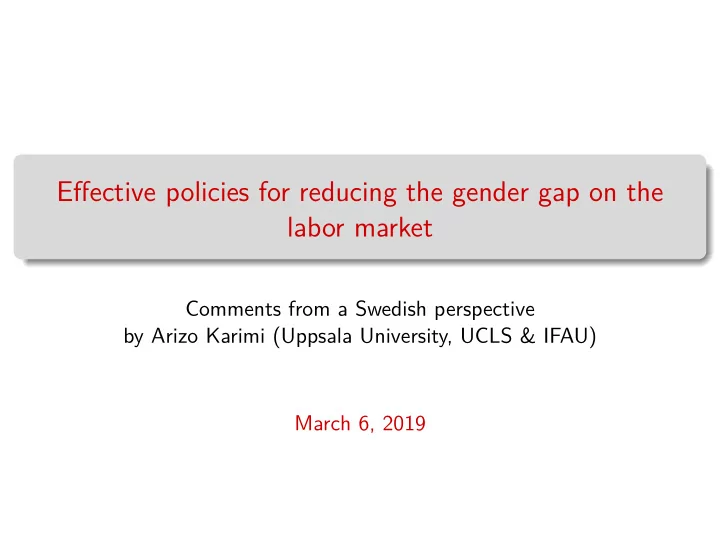

Effective policies for reducing the gender gap on the labor market Comments from a Swedish perspective by Arizo Karimi (Uppsala University, UCLS & IFAU) March 6, 2019
Sweden: reached the 2009 OECD average level of female labor force participation already in 1974 Widespread belief that family policies have been helpful Large expansion of paid parental leave since its (in international standards) early introduction in 1974 However, polices not only shape but are also shaped by changing economic conditions and norms 1 / 16
Figure 1: Labor force participation rates (annual avgs. in percent) of married and unmarried women aged 25-54 ( Source : Selin, 2014) 2 / 16
Figure 2: Labor force participation rates (annual avgs. in percent) ( Source : SOU 1975:62) 3 / 16
What may be the explanations for these trends? Change in the industry composition: shift away from manufacturing in favor of service sector Employment in public administration increased by over 75% over the period 1960–1970 4 / 16
Figure 3: Population and employment in the private and public sectors ( Source : Bjuggren and Johansson, 2009 5 / 16
What may be the explanations for these trends? Change in the industry composition: shift away from manufacturing in favor of service sector Employment in public administration increased by over 75% over the period 1960–1970 6 / 16
What may be the explanations for these trends? Change in the industry composition: shift away from manufacturing in favor of service sector Employment in public administration increased by over 75% over the period 1960–1970 At the same time, female relative wages increased 6 / 16
What may be the explanations for these trends? Change in the industry composition: shift away from manufacturing in favor of service sector Employment in public administration increased by over 75% over the period 1960–1970 At the same time, female relative wages increased Changes in societal norms about “women’s role” 6 / 16
What may be the explanations for these trends? Change in the industry composition: shift away from manufacturing in favor of service sector Employment in public administration increased by over 75% over the period 1960–1970 At the same time, female relative wages increased Changes in societal norms about “women’s role” Policy changes largely a response to these developments? 6 / 16
Causal effects of family policies: Evidence from Sweden Policies that increase incentives for women’s time spent at home Extension of (existing) paid leave Benefit levels (e.g. speed premium) Policies that create substitutes for women’s time at home Use-it-or-lose-it paid leave to each parent (daddy months) Child care availability 7 / 16
Figure 4: Effect of additional month of paid leave on employment ( Source : Ginja, Karimi & Xiao (ongoing work) .01 Estimated eff. ( β 3 ): Participation 0 -.01 -.02 -.03 -2 -1 0 1 2 3 4 5 6 7 8 9 10 Year since birth 8 / 16
Figure 5: Effect of additional month of paid leave on earnings conditional on employment ( Source : Ginja, Karimi & Xiao (ongoing work) 1000 Estimated eff. ( β 3 ): Labor income 0 -1000 -2000 -3000 -2 -1 0 1 2 3 4 5 6 7 8 9 10 Year since birth 9 / 16
Figure 6: Effects of the first two daddy-month reforms on PL take-up (Source: Avdic & Karimi, 2018) 10 / 16
Figure 7: Effect of the first daddy-month reform on men’s take-up of leave to care for children when they are sick (Source: Ekberg et al., 2013) 11 / 16
Cheaper child care (Lundin et al., 2008) The Norwegian case (Dahl et al., 2016) The takeaway from literature: public policies seem to have limited impact on gender gaps in earnings or employment Alternative/complementary explanations? 12 / 16
Norms Figure 8: Estimated child penalties vs. elicited gender norms (Source: Kleven et al., 2019) 13 / 16
The marriage market (comparative advantage) Figure 9: Effect of kids on the within-couple earnings gap by quantile of pre-birth earnings gap (Source: Angelov et al., 2016) 14 / 16
Policies that lead to the erosion of the single-earner (male breadwinner) household Individual taxation of spouses? Paternity leave provisions? Child care subsidies and availability? Also Structural changes in the labor market ...feeds into norms, affect individuals’ human capital decisions and matching, which affects household allocation of time, which feeds into norms... 15 / 16
Concluding remarks Most of the literature focuses on specific family policies/reforms in isolation Need to better understand potential complementarities between different policies (paid leave/job protection/right to part-time arrangements/child care subsidies) Need to consider the long-run effects of public policy in general equilibrium 16 / 16
Recommend
More recommend